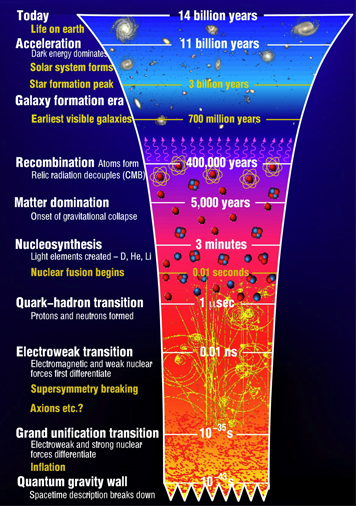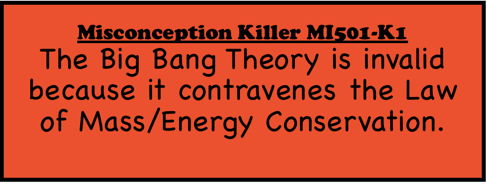MS501: Miscon One:
The "Big Bang Theory" is a Giant Misconception
David Noel
<davidn@aoi.com.au>
Ben Franklin Centre for Theoretical Research
PO Box 27, Subiaco, WA 6008, Australia.
What is the Big Bang Theory?
The Big Bang Theory is a model (structural, historical, and descriptive picture) of the totality of our Universe. A summary of what it means and implies is contained in the following extract from Wikipedia [1].
"The Big Bang theory is the prevailing cosmological model for the observable universe, from the earliest known periods through its subsequent large-scale evolution. The model describes how the universe expanded from a very high-density and high-temperature state, and offers a comprehensive explanation for a broad range of phenomena, including the abundance of light elements, the cosmic microwave background (CMB), large scale structure, and Hubble's law (the farther away galaxies are, the faster they are moving away from Earth).
If the observed conditions are extrapolated backwards in time using the known laws of physics, the prediction is that just before a period of very high density there was a singularity which is typically associated with the Big Bang. Detailed measurements of the expansion rate of the universe place the Big Bang at around 13.8 billion years ago, which is thus considered the age of the universe".
About Scientific Models
In a scientific model, a scenario is set up to describe a given system or section of the real world, and values are assigned or postulated for the various forces or bodies within that system. Once a model is set up and described, it is open to anyone to look at what the model describes or predicts for its equivalent in the real world, and see how well theory (the model) matches with reality (observation or measurements).
In this situation, the model is fair game for anyone to put up an alternative improved or replacement model. The supposed "rules" of scientific enquiry say that if the improved or replacement model gives a closer match to actuality than the old model, the new model should be accepted.
Unfortunately, "should" is not "will". For acceptance, any new model has to overcome a host of obstacles and entrenched guild-nepotisms which are unconnected with logic or reason. For more on this, see AC601: Acceptance of new scientific concepts and the Science Jury mechanism.
The present article will show how the existing Big Bang Theory is a giant misconception or Miscon, with some its basic elements no longer able to stand up when approached with modern logic, reasoning, and observation.
How did the Big Bang Theory get started?
The Big Bang Theory got started back in the 1920s, after astronomer Edwin Hubble showed that lines in the light spectra of distant galaxies showed displacements ("Red-Shifts") which were greater, the further away were the galaxies giving rise to the spectra.
In Wikipedia [1], it says "American astronomer Edwin Hubble observed that the distances to faraway galaxies were strongly correlated with their redshifts. This was interpreted to mean that all distant galaxies and clusters are receding away from our vantage point with an apparent velocity proportional to their distance: that is, the farther they are, the faster they move away from us, regardless of direction".
This behaviour was incorporated in a new model called the "Expanding Universe". Hubble's finding, that red-shifts were correlated with distances of galaxies, was of huge value in improving understanding of the Universe, although Hubble himself did not believe that red-shifts meant the Universe was expanding. Nevertheless, the "Expanding Universe" idea gradually took over general acceptance, in spite of a better explanation put forward by the brilliant astrophysicist Fritz Zwicky, which was never properly evaluated at the time.
The name "Big Bang" was actually a derisive description applied by astronomer Fred Hoyle during the 1940s -- Hoyle did not accept that the Universe had a beginning, but thought it had always existed, and supported an alternative "Steady State" theory in which the large-scale structure of the Universe remained more or less the same.
In this article, it will be shown that Zwicky and Hoyle were right, and that the evidence does not support the idea of an Expanding Universe.
Details of the Big Bang model
According to the Big Bang, the Universe came into existence a little under 14 billion years ago. The model says it started from a "singularity" (a dimensionless point), which expanded, during the first very tiny fractions of a second, into the Universe we know of today.
An immense amount of effort has been expended by mathematicians and astronomers to delineate the supposed stages of this expansion. The following graphic shows how the transitions are supposed to have happened.

Figure MI501-F1. Progress of the "Big Bang". From [2].
With its mass of esoteric terminology -- "Quantum gravity wall", "Grand unification transition", "Electroweak transition", and "Quark-hadron transition" (all events supposed to have occurred during the first millionth of a second), this picture is guaranteed to bullshit the vast majority, scientists and laymen alike. The standard presumption is, that all this complex work could not possibly be wrong, could only be the accepted view, representing as it does the entire careers and output of some academics.
The real truth is somewhat sobering. The Big Bang Theory is a Giant Misconception. It has to be wrong, because it contravenes one of the most basic laws of science, the Law of Conservation of Mass/Energy.
This law was first formulated in two separate parts, one relating to Mass, the other to Energy. The law of conservation of mass states that for any system closed to all transfers of matter and energy, the mass of the system must remain constant over time. Hence, the quantity of mass is conserved over time [3].
Historically, mass conservation was demonstrated in chemical reactions independently by Mikhail Lomonosov and later rediscovered by Antoine Lavoisier in the late 18th century. The formulation of this law was of crucial importance in the progress from alchemy to the modern natural science of chemistry.
The law of conservation of energy, a fundamental concept of physics, states that the total amount of energy remains constant in an isolated system. It implies that energy can neither be created nor destroyed, but can be changed from one form to another [4].
In more modern times, with the realization that matter can be converted into energy, and vice versa, the two laws are combined into the Law of Conservation of Mass/Energy. The amounts of matter and energy involved are defined in Einstein's well-known equation, E=mc2.

So, from the scientific viewpoint, The Big Bang Theory must be regarded as invalid, because it contravenes one of the most fundamental scientific laws.
The standpoint of commonsense also completely rules out the Big Bang Theory. It's ludicrous to suggest that an entire universe could develop suddenly out of nothing. The creation of the Universe has been the subject of more than a hundred "Creation Myths" [5]. The Big Bang Theory is just one of the hundred, it's no more "scientific" than suggesting the universe came from a giant egg laid by a spirit bird.
So, having ruled out the Big Bang as the creation point of the Universe, what questions remain?
What about the Red Shift?
It will be remembered that the Big Bang theory came about as an attempt to explain the Red Shift in the spectra of light from distant galaxies. It's a very real phenomenon, if it's not from galaxies expanding away from us, what causes it?
In fact it's quite easy to find a much better explanation for Red-Shift than as a Doppler Effect due to bodies moving away from us, and even to prove that Doppler cannot account for features observe in real galactic red-shift. For this, see MI502: Miscon Two: "Expansion of the Universe" is a Giant Misconception.
What about CMBR?
Cosmic Microwave Background Radiation, CMBR, was discovered accidentally in 1965. It's an all-pervading part of the radiation energy which permeates the Universe -- in fact, it is the major part, accounting for over 70% of this energy.
It's of relevance here because when CMBR was discovered, it was claimed to be one of the effects of the Big Bang. And then it was not long before it came to be quoted as one of the main pieces of evidence supporting the Big Bang!
In the event, it's quite easy to demonstrate the real origin of CMBR, nothing to do with the Big Bang or with any event in the past history of the Universe. For this, see MI502: Miscon Three: "CMBR originated in the Big Bang" is a Giant Misconception.
When did the Universe begin?
The only really satisfactory answer to this question is, that "The Universe is Eternal", and so had no beginning. Those who believe this include Stephen Hawking [6], Albert Einstein [7], and a surprisingly large number of other famous people.
One of the first questions asked by people who come across the Big Bang theory (pegged at 13.8 billion years ago), is "What was happening before the Big Bang?". The second question asked about it, or any other creation theory, is, "Who created the creator?". Of course answers here just lead to a further question one step back.
However hard it may be to accept the idea of an eternal (and infinite) Universe, it must be the winner according to the rule quoted above, because it does give the best match with reality and observation. But there is one consequence of this concept.
The Universe around us is changing and evolving, even if very slowly. If it is eternal, then the objects we see must be being recycled. The Universe undergoes small-scale change, yet achieves very-large-scale uniformity. And this is just what is observed.
In UG101: Recycling the Universe -- Neutron Stars, Black Holes, and the Science of Stuff, I show how this recycling occurs. It is slow, for an average galaxy like our Milky Way, the cycle time is as long as 20 billion years -- but all the broad steps have now been revealed.
* * * * * * * * * * * * * * * * * *

References and Links
[1]. Big Bang. https://en.wikipedia.org/wiki/Big_Bang .
[2]. The Origins of the Universe: the Big Bang. http://www.ctc.cam.ac.uk/outreach/origins/big_bang_three.php .
[3]. Conservation of mass.
https://en.wikipedia.org/wiki/Conservation_of_mass/ .
[4]. Law of Conservation of Energy and Mass.
https://www.neok12.com/Law-of-Conservation.htm .
[5]. List of creation myths. http://en.wikipedia.org/wiki/List_of_creation_myths .
[6]. Adrian Cho. Stephen Hawking's (almost) last paper: putting an end to the beginning of the universe. https://www.sciencemag.org/news/2018/05/stephen-hawking-s-almost-last-paper-putting-end-beginning-universe .
[7]. Amir Aczel. Einstein's Lost Theory Describes a Universe Without a Big Bang. http://blogs.discovermagazine.com/crux/2014/03/07/einsteins-lost-theory-describes-a-universe-without-a-big-bang/#.XUAAgpMzbdo .
Go to the Acceptology Home Page

Version 1.0 compilation started 2019 Jul 18, first version on Web 2019 Jul 30.





